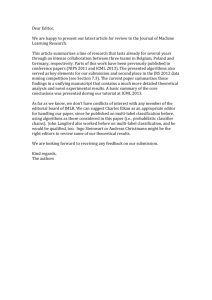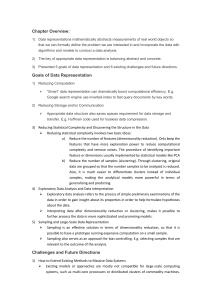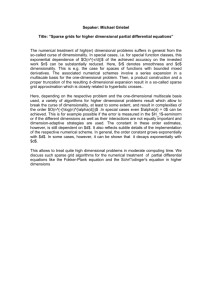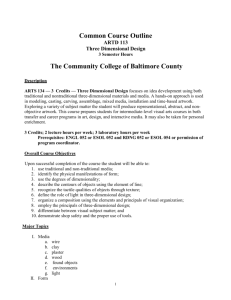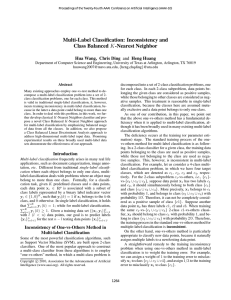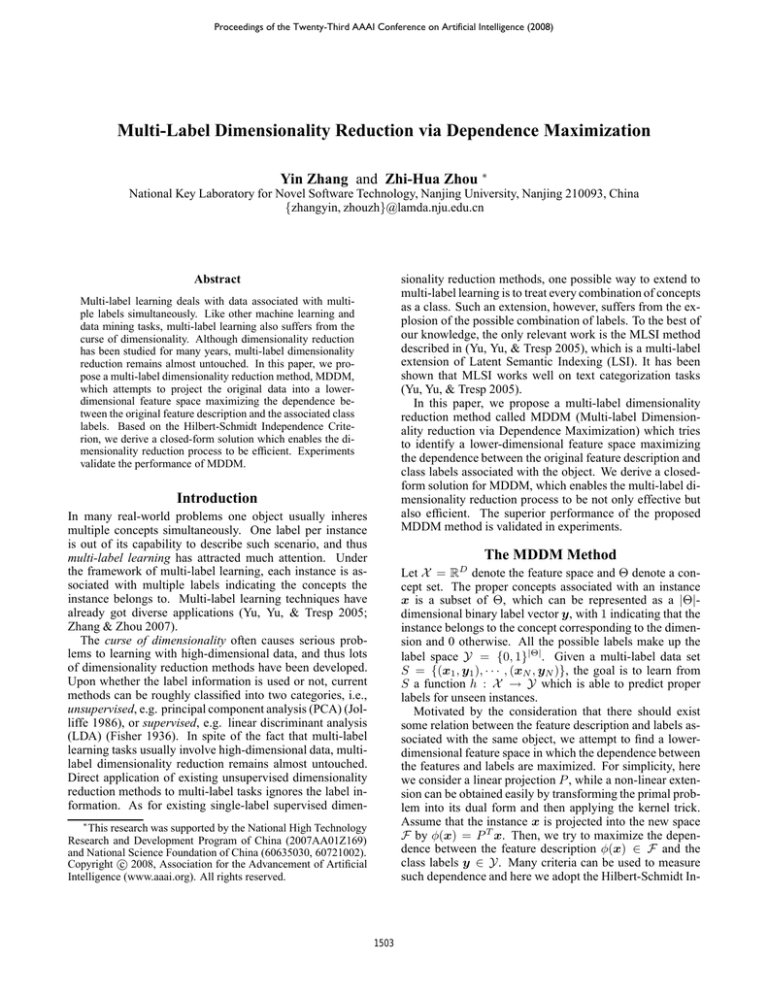
Proceedings of the Twenty-Third AAAI Conference on Artificial Intelligence (2008)
Multi-Label Dimensionality Reduction via Dependence Maximization
Yin Zhang and Zhi-Hua Zhou ∗
National Key Laboratory for Novel Software Technology, Nanjing University, Nanjing 210093, China
{zhangyin, zhouzh}@lamda.nju.edu.cn
sionality reduction methods, one possible way to extend to
multi-label learning is to treat every combination of concepts
as a class. Such an extension, however, suffers from the explosion of the possible combination of labels. To the best of
our knowledge, the only relevant work is the MLSI method
described in (Yu, Yu, & Tresp 2005), which is a multi-label
extension of Latent Semantic Indexing (LSI). It has been
shown that MLSI works well on text categorization tasks
(Yu, Yu, & Tresp 2005).
In this paper, we propose a multi-label dimensionality
reduction method called MDDM (Multi-label Dimensionality reduction via Dependence Maximization) which tries
to identify a lower-dimensional feature space maximizing
the dependence between the original feature description and
class labels associated with the object. We derive a closedform solution for MDDM, which enables the multi-label dimensionality reduction process to be not only effective but
also efficient. The superior performance of the proposed
MDDM method is validated in experiments.
Abstract
Multi-label learning deals with data associated with multiple labels simultaneously. Like other machine learning and
data mining tasks, multi-label learning also suffers from the
curse of dimensionality. Although dimensionality reduction
has been studied for many years, multi-label dimensionality
reduction remains almost untouched. In this paper, we propose a multi-label dimensionality reduction method, MDDM,
which attempts to project the original data into a lowerdimensional feature space maximizing the dependence between the original feature description and the associated class
labels. Based on the Hilbert-Schmidt Independence Criterion, we derive a closed-form solution which enables the dimensionality reduction process to be efficient. Experiments
validate the performance of MDDM.
Introduction
In many real-world problems one object usually inheres
multiple concepts simultaneously. One label per instance
is out of its capability to describe such scenario, and thus
multi-label learning has attracted much attention. Under
the framework of multi-label learning, each instance is associated with multiple labels indicating the concepts the
instance belongs to. Multi-label learning techniques have
already got diverse applications (Yu, Yu, & Tresp 2005;
Zhang & Zhou 2007).
The curse of dimensionality often causes serious problems to learning with high-dimensional data, and thus lots
of dimensionality reduction methods have been developed.
Upon whether the label information is used or not, current
methods can be roughly classified into two categories, i.e.,
unsupervised, e.g. principal component analysis (PCA) (Jolliffe 1986), or supervised, e.g. linear discriminant analysis
(LDA) (Fisher 1936). In spite of the fact that multi-label
learning tasks usually involve high-dimensional data, multilabel dimensionality reduction remains almost untouched.
Direct application of existing unsupervised dimensionality
reduction methods to multi-label tasks ignores the label information. As for existing single-label supervised dimen-
The MDDM Method
Let X = RD denote the feature space and Θ denote a concept set. The proper concepts associated with an instance
x is a subset of Θ, which can be represented as a |Θ|dimensional binary label vector y, with 1 indicating that the
instance belongs to the concept corresponding to the dimension and 0 otherwise. All the possible labels make up the
label space Y = {0, 1}|Θ|. Given a multi-label data set
S = {(x1 , y1 ), · · · , (xN , yN )}, the goal is to learn from
S a function h : X → Y which is able to predict proper
labels for unseen instances.
Motivated by the consideration that there should exist
some relation between the feature description and labels associated with the same object, we attempt to find a lowerdimensional feature space in which the dependence between
the features and labels are maximized. For simplicity, here
we consider a linear projection P , while a non-linear extension can be obtained easily by transforming the primal problem into its dual form and then applying the kernel trick.
Assume that the instance x is projected into the new space
F by φ(x) = P T x. Then, we try to maximize the dependence between the feature description φ(x) ∈ F and the
class labels y ∈ Y. Many criteria can be used to measure
such dependence and here we adopt the Hilbert-Schmidt In-
∗
This research was supported by the National High Technology
Research and Development Program of China (2007AA01Z169)
and National Science Foundation of China (60635030, 60721002).
c 2008, Association for the Advancement of Artificial
Copyright Intelligence (www.aaai.org). All rights reserved.
1503
dependence Criterion (HSIC) (Gretton et al. 2005) due to its
simplicity and neat theoretical properties.
An empirical estimate of HSIC (Gretton et al. 2005) is
HSIC(F , Y, Pxy ) = (N − 1)−2 tr (HKHL) ,
MDDM(X, Y , d or thr)
Input:
X : D × N feature matrix
Y : Q × N label matrix
d : the dimensionality to be reduced to
thr: a threshold
Process:
1 Construct the label kernel matrix L
2 Compute XHLHX T
3 if d is given
4
Do eigenvalue decomposition on XHLHX T , then
construct D × d matrix P whose columns are
composed by the eigenvectors corresponding to the
largest d eigenvalues
5 else (i.e., thr is given)
6
Construct D × r matrix P̃ in a way similar to
Step 4 where r is the rank of L, then choose the
P
first d eigenvectors
that enable di=1 λi ≥ thr ×
`P
´
r
i=1 λi to compose P
(1)
where Pxy is the joint distribution and tr(·) is the trace of
matrix. K = [Kij ]N ×N and L = [Lij ]N ×N are the matrices
of the inner product of instances in F and Y which could
also be considered as the kernel matrices of X and Y with
kernel functions k(x, x′ ) = hφ(x), φ(x′ )i = hP T x, P T x′ i
and l(y, y ′ ) = hy, y ′ i. H = [Hij ]N ×N , Hij = δij − 1/N ,
δij takes 1 when i = j and 0 otherwise.
Since the normalization term in Eq. 1 does not affect
the optimization procedure, we can drop it and only consider tr (HKHL). Denote X = [x1 , · · · , xN ] and Y =
[y1 , · · · , yN ]. Thus φ(X) = P T X and K = hφ(X),
φ(X)i = X T P P T X, L = Y T Y . We can rewrite the optimization as searching for the optimal linear projection
P ∗ = arg max tr HX T P P T XHL .
(2)
7 end if
Output:
P : the projection from RD to Rd
P
Suppose we will reduce to a d-dimensional space and denote P = [P1 , · · · , Pd ] (d ≪ D), the column vectors of
the matrix P forms a basis spanning of the new space. By
constraining the basis to be orthonormal, we have
max tr HX T P P T XHL
s.t. PiT Pj = δij . (3)
Figure 1: Pseudo-code of the MDDM method
In contrast to previous HSIC methods which greedily selected a subset of features (Song et al. 2007) or using gradient descent to find a local optimal under the constraint of
distance preserving (Song et al. 2008), we have a close-form
solution for our purpose, which is effective and efficient.
Note that HSIC is just one among the many choices we
can take to measure the dependence. We have also evaluated canonical component analysis (Hardoon, Szedmak, &
Shawe-Taylor 2004) yet the speed is slower than the current
MDDM. So we only report the results with HSIC here.
P
To solve the problem, we have
!
d
X
T
T
tr HX P P XHL = tr
HX Pi Pi XHL
T
T
i=1
=
d
X
i=1
tr HX T Pi PiT XHL =
d
X
i=1
PiT XHLHX T Pi
(4)
Experiments
The optimal Pi∗ ’s (1 ≤ i ≤ d) can be obtained easily by
the Lagrangian method. If the eigenvalues of XHLHX T
are sorted as λ1 ≥ · · · ≥ λD , the optimal Pi∗ ’s are the normalized eigenvectors corresponding to the largest d eigenvalues. Since XHLHX T is symmetric, the eigenvalues
are all real. If the optimal projection P ∗ has been obP
tained, the corresponding HSIC value is di=1 λi . Since
the eigenvalues reflect the contribution of the corresponding dimensions, we can control d by setting a threshold thr
(0 ≤ thr ≤ 1) and then choosing the first d eigenvectors
Pd
Pr
such that i=1 λi ≥ thr × ( i=1 λi ). Thus, the optimization problem reduces to deriving eigenvalues of a D × D
matrix and the computational complexity is O(D3 ). The
Pseudo-code of the MDDM method is shown in Figure 1.
In the above analysis, we use inner product as kernel function on Y, i.e., l(y, y ′ ) = hy, y ′ i. If such a simple linear kernel is insufficient to capture the correlation between
concepts, we can use a more delicate kernel function, e.g.
quadratic or RBF. If Lij can encode the correlation between
labels yi and yj , the dimensionality reduction process can
get a better result with the guidance of L.
We compare MDDM with three methods, including the linear dimensionality reduction method PCA (Jolliffe 1986),
nonlinear dimensionality reduction method LPP (He &
Niyogi 2004), and the only available multi-label dimensionality reduction method MLSI (Yu, Yu, & Tresp 2005). The
multi-label k-nearest neighbor method ML-kNN with default setting k = 10 (Zhang & Zhou 2007) is used for classification after dimensionality reduction. As a baseline, we
also evaluate the performance of ML-kNN in the original
feature space (denoted by ORI). For LPP, the number of
nearest neighbors used for constructing adjacency graph is
as the same as that used in ML-kNN for classification. For
MLSI, the parameter β is set to 0.5 as recommended in (Yu,
Yu, & Tresp 2005). In the first series of experiments, the dimensionality of the lower-dimensional space, d, is decided
by setting thr = 99%. All dimensionality reduction methods reduce to the same dimensionality. The performance
under different d values will be reported later in this section. For MDDM, we have evaluated different l(·, ·) (linear,
quadratic and RBF) while the results are similar. So, here
we only report the simplest case, i.e., the linear kernel.
1504
Table 1: Average results (mean±std.) on 11 Yahoo data sets (↓ indicates “the smaller the better”; ↑ indicates “the larger the better”)
Hamming Loss (×10−1 ) ↓
One-error ↓
Coverage (×10) ↓
Ranking Loss ↓
Average Precision ↑
MDDM
MLSI
PCA
LPP
ORI
0.394±0.134
0.415±0.135
0.381±0.116
0.092±0.038
0.665±0.103
0.499±0.172
0.539±0.066
0.888±0.223
0.247±0.091
0.489±0.061
0.426±0.142
0.469±0.155
0.417±0.129
0.104±0.042
0.624±0.115
0.437±0.144
0.488±0.161
0.433±0.131
0.109±0.045
0.607±0.119
0.432±0.145
0.471±0.157
0.410±0.124
0.102±0.045
0.625±0.116
We evaluate the performance of the compared methods
using five criteria which are popularly used in multi-label
learning, i.e., hamming loss, one-error, coverage, ranking
loss and average precision. These criteria evaluate multilabel learning methods from different aspects, and it is difficult for one method to be better than another over all the
criteria. Details of these criteria can be found in (Zhang &
Zhou 2007).
Eleven web page classification data sets 1 are used in our
experiments. The web pages were collected from the “yahoo.com” domain. Each data set corresponds to a top-level
category of Yahoo. The web pages are classified into a number of second-level subcategories, and thus, one web page
may belong to several subcategories simultaneously. Details
of these data sets can be found in (Zhang & Zhou 2007).
The average results are shown in Table 1 where the best
result on each evaluation criterion is highlighted in boldface.
It is impressive that, pairwise t-tests at 95% significance
level reveal that MDDM is significantly better than all the
other methods on all the evaluation criteria.
We also study the performance of the compared methods under different d, i.e., the dimensionality of the lowerdimensional space. We run experiments with d from 2% to
100% of the original space’s dimensionality, with 2% as interval. Due to the page limit, we only present the results on
Hamming loss which is arguably the most important multilabel evaluation criterion. It can be found from Figure 2(a)
that the performance of MDDM with any d value is better
than the best performance of the compared methods with
their optimal d values. It is clear that MDDM is superior to
the compared methods.
It is interesting to study that whether MDDM can also
work well with different settings of k. So, we run experiments with k values ranging from 6 to 10 under the same
d as that used in the first series of experiments. The results
measured by Hamming loss are shown in Figure 2(b). It is
nice to see that the performance of MDDM is quite robust to
the setting of k, always better than the other methods.
Hamming Loss
6.0
MLSI
PCA
LPP
6.0
ORI
5.5
5.0
4.5
4.0
3.5
0
x 10 −2
MDDM
MLSI
PCA
LPP
ORI
5.5
5.0
4.5
4.0
20
40
60
80
100
3.5
6
8
10
12
14
k
Dimension Percent (%)
(a) Different dimensionalities
(b) Different k values
Figure 2: Average results on eleven Yahoo data sets
induction of the lower-dimensional space. The label matrix
L encoding the label correlation plays an important role in
MDDM. Designing a better method for constructing L is an
important future work.
Acknowledgements We what to thank Kai Yu for providing
the code of MLSI, and De-Chuan Zhan and Yang Yu for
helpful discussion.
References
Fisher, R. A. 1936. The use of multiple measurements in
taxonomic problems. Annals of Eugenics 7(2):179–188.
Gretton, A.; Bousquet, O.; Smola, A. J.; and Schölkopf,
B. 2005. Measuring statistical dependence with HilbertSchmidt norms. In ALT, 63–77.
Hardoon, D. R.; Szedmak, S.; and Shawe-Taylor, J.
2004. Canonical correlation analysis: An overview with
application to learning methods. Neural Computation
16(12):2639–2664.
He, X., and Niyogi, P. 2004. Locality preserving projections. In NIPS 16.
Jolliffe, I. T. 1986. Principal Component Analysis. Berlin:
Springer.
Song, L.; Smola, A.; Gretton, A.; Borgwardt, K.; and
Bedo, J. 2007. Supervised feature selection via dependence estimation. In ICML, 823–830.
Song, L.; Smola, A.; Borgwardt, K.; and Gretton, A. 2008.
Colored maximum variance unfolding. In NIPS 20. 1385–
1392.
Yu, K.; Yu, S.; and Tresp, V. 2005. Multi-label informed
latent semantic indexing. In SIGIR, 258–265.
Zhang, M.-L., and Zhou, Z.-H. 2007. ML-kNN: A lazy
learning approach to multi-label learning. Pattern Recognition 40(7):2038–2048.
Conclusion
In this paper, we propose the MDDM method, which performs multi-label dimensionality reduction by maximizing
the dependence between the feature description and the associated class labels. It is easy to design variants of MDDM
by using dependence measures other than HSIC to guide the
1
x 10 −2
MDDM
Hamming Loss
Criterion
http://www.kecl.ntt.co.jp/as/members/ueda/yahoo.tar.gz
1505


